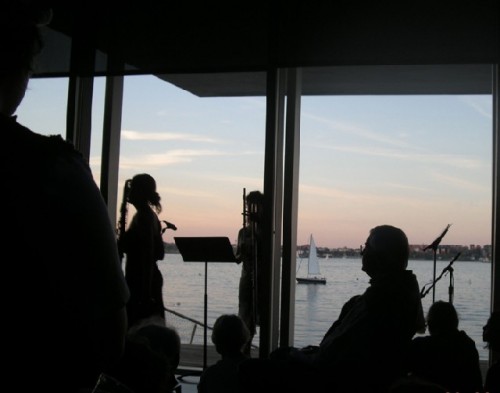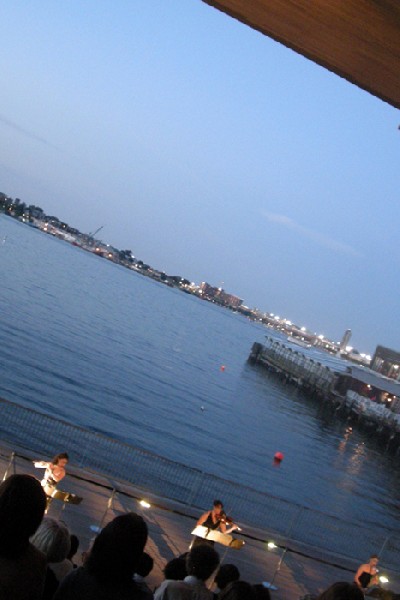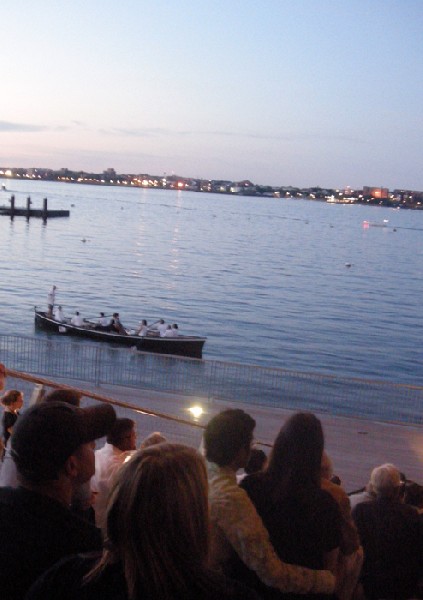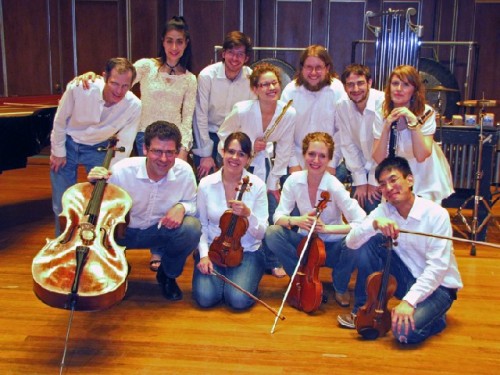Callithumpian Consort at ICA/Boston
The Sinking of the Titanic
By: Erica H. Adams - Aug 21, 2010
The Sinking of the Titanic
Callithumpian Consort
ICA/Boston
August 20, 2010
ICA/Boston presented British composer Gavin Bryar’s The Sinking of the Titanic performed by new music ensemble Callithumpian Consort as a post-crash dirge. The Consort delivered a thought provoking experience for our era characterized by hope and bold restructuring countered by willful obstructionists. For a culture hooked on drama, in its place, spectators experienced the expanded moment of dank, murky inertia and panic that passengers may have felt in the 2 ½ hours after the “unsinkable” luxury liner Titanic hit an iceberg then, sank. There was an overwhelming sense of forging through the dark at the End of the Empire.
The two-part performance began with the audience literally, standing in the dark, on the stage defined by curtained walls and a palpable sense of uncertainty. Watery sounds drifted by ‘passengers’ as waves crashed, signals warned of danger and, first person narratives were cut short. The bar was busy. A single computer-aided musician appeared to generate the sound until curtains opened to reveal two musicians and the harbor behind the theater’s glass wall. Slowly, dread-filled notes of a saxophone and a flute saturated the room, now, an ocean-facing deck at night’s edge. Musicians re-grouped inside with a cellist. The band played on, then stopped abruptly and walked outside onto the actual harbor-side deck as ‘passengers’ followed.
Outside for the second act, three musicians played briefly, while the audience listened a sense of uncertainty and dislocation, reasserted itself. A lifeboat arrived filled with passengers entertained by a cellist's reassuring sound. We watched as the remaining musicians glided away in this same lifeboat. Later, it was clear: we spectators were the majority of the Titanic’s passengers who didn’t survive. A time to act or, a time to watch: choose your hand.
British composer Gavin Bryar intended The Sinking of the Titanic as the musical equivalent of a conceptual art work. It succeeded. But, the pervasive sense of the End of the Empire pervading his piece referenced another British composer, Sir Edward Elgar known for his music for the end of time. Inspired by shipwrecked accounts of survivor’s and ironic fact, the “unsinkable” luxury liner Titanic’s band performed hymns as it sank: Bryars’s ocean-themed sound installation progressed from calamity to contemplative finale to offers our times a survivor’s metaphor.
In 1912, the Titanic struck an iceberg at 11:40 p.m. and sank into the North Atlantic in at 2:20 a.m. April 15th, playing “Autumn”. A third of its passengers reached their destination, in New York City. Harold Bride, the junior wireless operator, in a New York Times interview on April 19th 1912 explained ". . . from aft came the tunes of the band . . . . . The way the band kept playing was a noble thing. I heard it first while we were still working wireless, when there was a ragtime tune for us, and the last I saw of the band, when I was floating out in the sea with my lifebelt on, it was still on deck playing "Autumn". How they ever did it I cannot imagine." The string sextet played on to the end as it descended under water which provoked "The Sinking of the Titanic" (1969) composer Gavin Bryars to speculate on the sound: “On a poetic level, however, the music, once generated in water, would continue to reverberate for long periods of time in the more sound-efficient medium of water and the music would descend with the ship to the ocean bed and remain there, repeating over and over until the ship returns to the surface and the sounds re-emerge”. Apparently, sounds "decay" at different rates in various atmospheric conditions but never disappear, altogether, remaining out there, somewhere.
The Callithumpian Consort is dedicated to music as an experience. Founded by pianist-conductor Stephen Drury, this ensemble produces contemporary music concerts of the highest caliber. Flexible in size and makeup, The Consort is able to grapple with unusual repertoire and experimental projects in non-standard or larger chamber ensembles. Crossing a vast stylistic spectrum, from classics of the last half-century to works in avant-garde and experimental jazz and rock, the Callithumpian Consort has worked with composers John Cage, Lee Hyla, John Zorn, Michael Finnissy, Franco Donatoni, Lukas Foss, Steve Reich, Helmut Lachenmann, John Luther Adams, Frederic Rzewski, Christian Wolff and many others.






